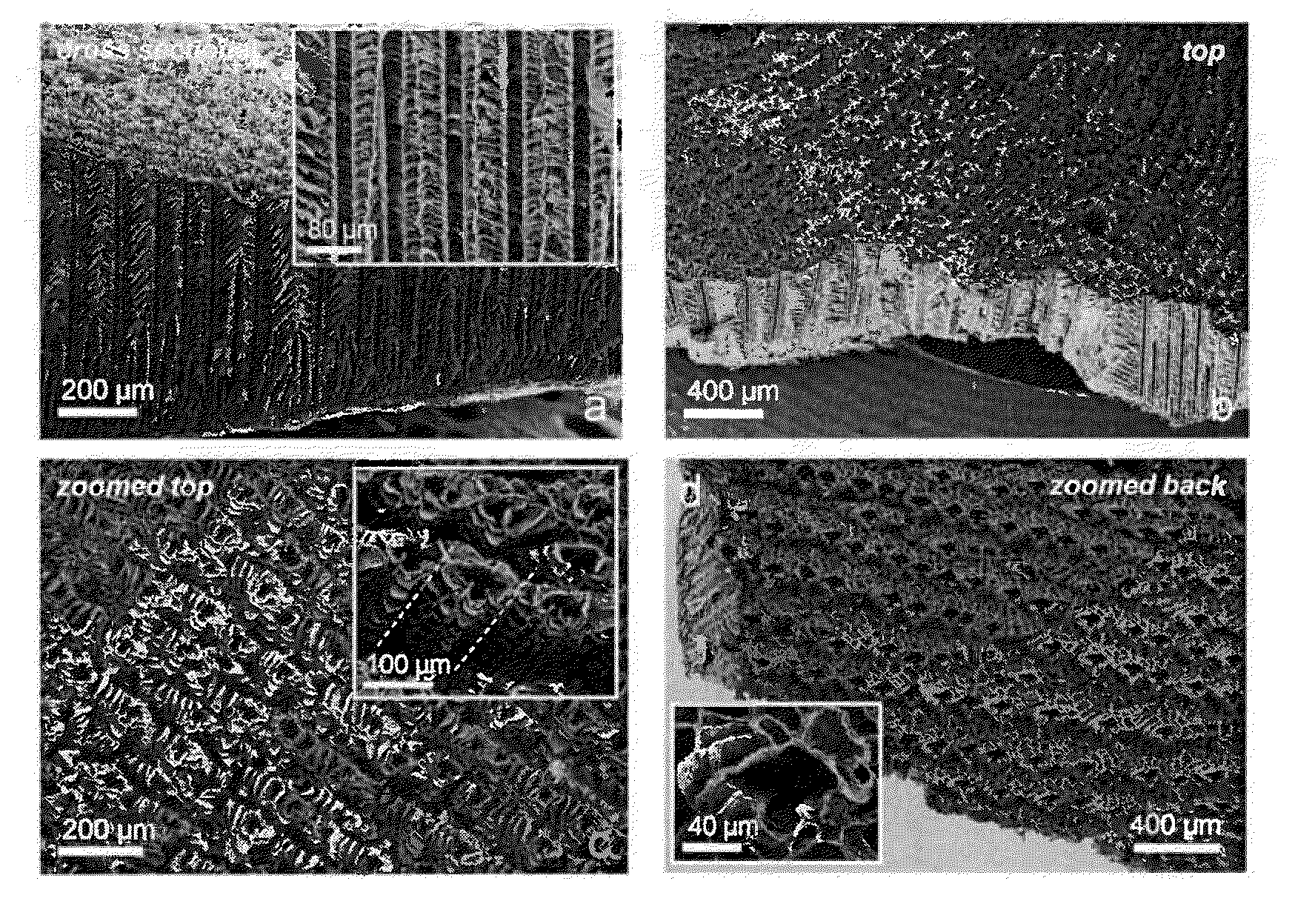Highly porous solid material made of biodegradable polymer and method of fabricating, processing, and cell-seeding the same
a biodegradable polymer and solid material technology, applied in the direction of domestic cooling devices, lighting and heating devices, support, etc., can solve the problems of partial erosion of the structure, loss of important morphological features, and difficulty in re-building healthy thick tissues, etc., to achieve culture success
- Summary
- Abstract
- Description
- Claims
- Application Information
AI Technical Summary
Benefits of technology
Problems solved by technology
Method used
Image
Examples
example 1
(1) Scaffold Synthesis
[0046]Commercial PLLA (Mwa=100,000-150,000, Aldrich, USA) was dissolved in 1,4-dioxane (Aldrich, USA) at the fixed concentration of 6.4 wt %. 10 ml of the solution was cast into a circular poly-tetrafluoroethlene mold (inner diameter: 45 mm, inner depth: 30 mm), and the solution-containing mold was mounted onto a cold finger (FIG. 1) thermally driven Al plate set at −40° C. (the temperature to be assumed that the resulting channel size in the scaffolds would be large enough to accommodate cells) and thus the thermal gradient was applied for 10 hours (time enough to reach the thermal equilibrium at −40° C.) from the bottom to the top of the solution free surface, in the perpendicular direction. After solidification, the samples were immersed into 100 ml of an 80 wt % ethanol aqueous solution to leach out the solvent or 1,4-dioxane. The only parameter affecting the speed of the dioxane extraction process is the 80 wt % ethanol bath temperature; too high extractin...
example 2
[0053](1) Cell Deep Seeding and Cell Culturing on dTIPS 3D Scaffold:
[0054]If not clearly stated differently, all the biological validation tests were performed on the PLLA scaffolds fabricated by dTIPS at −40° C. Before cell seeding, scaffolds undergo a preliminary vacuum treatment aimed to replace the air trapped within the porous cavities with cell-free culture medium, in order to permit homogeneous cell culturing in the entire scaffold volume. The 14 mm diameter round scaffolds were EtOH rinsed, vacuum dried, and UV sterilized for 5 minutes per each side. Each sample was then placed into a 10 mL plastic syringe having same diameter of the cylindrical scaffold, locked to the bottom with a polytetrafluoroethylene (PTFE) cylinder as shown in FIG. 5a. The syringe was partially immersed in a culture medium containing petri-dish (not shown) from where the culture medium fluid was forced to pass through the scaffold porosity by repeated aspiration and subsequent air expulsion as shown i...
example 3
[0058](1) 2D dTIPS Scaffold Smart Cut Fabrication:
[0059]As already stated, the present invention also provides a method of fabricating planar thin (20-70 μm) scaffolds having oriented dendrite-like porosity, otherwise unachieved so far by dTIPS. This method is a top-down approach starting from the 3D dTIPS scaffold. Thin 2D scaffold were obtained as follows: the 3D dTIPS scaffold was positioned in a plastic syringe and locked by mean of PTFE rings. A 30% sucrose / PBS solution was prepared and stored in a 15 mL plastic tube, and used as embedding solution. Alternatively, a 2% bovine derived gelatin in H2O dissolved 0.1% in PBS, was used as embedding agent. Alternatively, other embedding solutions can be prepared, using materials and concentrations stated in the first paragraph of (2) Validation of . 6 mL of embedding agent were aspired into the syringe and forced to flow through the scaffold. The embedding solution is expelled and additional 6 mL are aspired again. The syringe outlet ...
PUM
| Property | Measurement | Unit |
|---|---|---|
| diameter | aaaaa | aaaaa |
| diameter | aaaaa | aaaaa |
| diameter | aaaaa | aaaaa |
Abstract
Description
Claims
Application Information
 Login to View More
Login to View More - R&D
- Intellectual Property
- Life Sciences
- Materials
- Tech Scout
- Unparalleled Data Quality
- Higher Quality Content
- 60% Fewer Hallucinations
Browse by: Latest US Patents, China's latest patents, Technical Efficacy Thesaurus, Application Domain, Technology Topic, Popular Technical Reports.
© 2025 PatSnap. All rights reserved.Legal|Privacy policy|Modern Slavery Act Transparency Statement|Sitemap|About US| Contact US: help@patsnap.com



